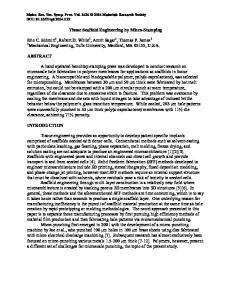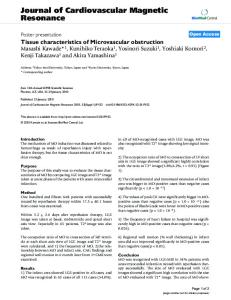A novel nanofiber scaffold by electrospinning and its utility in microvascular tissue engineering
- PDF / 521,156 Bytes
- 6 Pages / 595 x 842 pts (A4) Page_size
- 5 Downloads / 391 Views
AA5.48.1
A novel nanofiber scaffold by electrospinning and its utility in microvascular tissue engineering Dong Hana*, Sara Goldgrabenb, Mary D. Frameb, Pelagia-Irene Goumaa a
Department of Materials Science and Engineering, Stony Brook University, Stony Brook, NY 11794, USA b
Department of Biomedical Engineering, Stony Brook University, Stony Brook, NY 11794, USA
Abstract Cellulose acetate (CA) thin, porous membranes were produced by electrospinning precursor polymer solutions in acetone at room temperature. During this process, CA nanofibers were produced when a high electric field of 12 kV was applied to the precursor solution. The diameters of fibers obtained varied from 100 nm to 1.2 μm while the average diameter was approximately 500 nm. The electrospinning parameters used to control the morphology of the fibers and their membranes are flow rate, the distance between the syringe needle that ejects fluid and the collector, and the voltage applied. These membranes were used as scaffolds for microvascular cells growth. The structure of the membranes that were produced mimic the topography and porosity of extracellular matrix (ECM) in two key ways. The fiber diameter mimics extracellular protein fiber diameter, thus enabling cellular attachment and facilitating cellular migration. The porosity mimics that of extracellular matrix such that microvascular capillary tube formation is enhanced. The non-woven fiber mats were examined by means of electron microscopy and the nanofibers were seen to be oriented randomly. The issue of strengthening the CA scaffold is currently studied by adding ceramic nano-structured component (carbon nanotubes) in the polymer membranes. Keywords: electrospinning, cellulose acetate, microvascular, tissue engineering 1. Introduction In 1934, Formhals [1] patented a novel process for producing polymer fibers by using electrostatic force, which is called electrospinning. In this process, two electrodes are attached to the capillary of a syringe which contains the polymer solution and the collector respectively. Under the applied electric field, a polymer jet is formed and deposited on the collector, usually metal screen [2]. In this experiment, dry deposition conditions were used, only solutes can be finally deposited on the collector due to the evaporation of the solvent during the ejection process. By means of controlling the voltage of the electric field, the flow rate of the polymer solution, the distance *Corresponding author. E-mail address: [email protected] (Dong Han)
AA5.48.2
between the capillary and the collector and the concentration of the polymer solution, the diameters of nanofibers can be tailored easily. Table 1 summaries the process and solution parameters tested [3]. Table 1 Summary of the process and solution parameters [3]. Parameters of the electrospinning process
Flow rate of the polymer solution Voltage Distance between the syringe and the collector
Parameters of polymer solutions
Concentration Viscosity Surface tension
In the present work, we produ
Data Loading...











